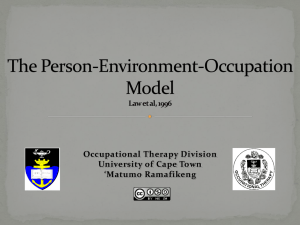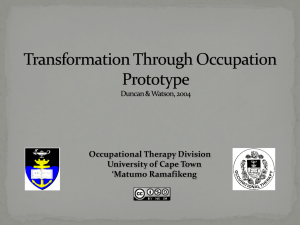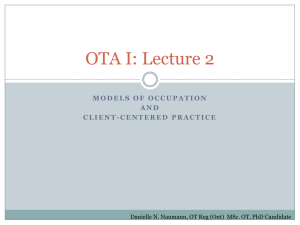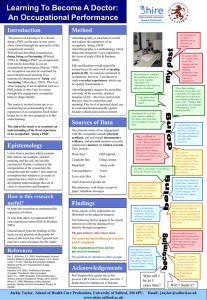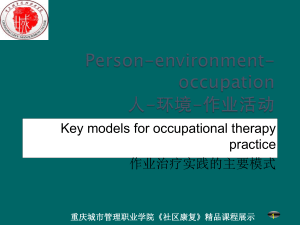6. The Occupational Therapy Practice framework
advertisement
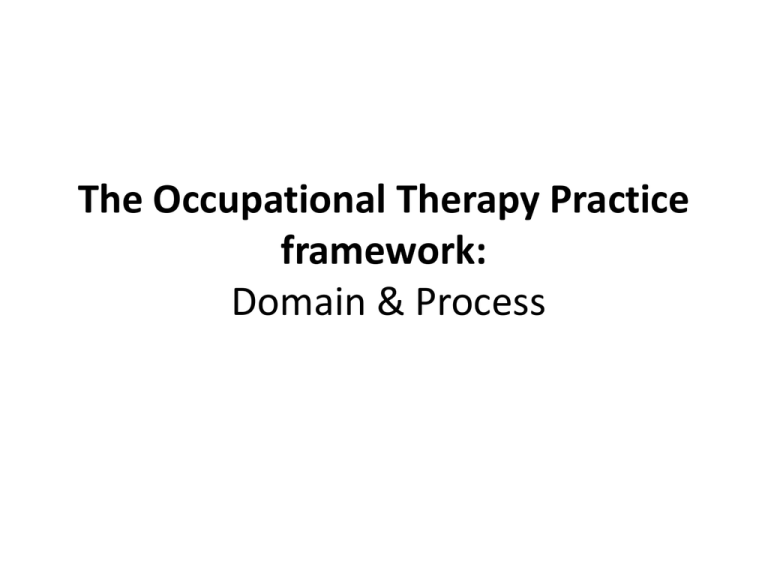
The Occupational Therapy Practice framework: Domain & Process The Occupational Therapy Practice framework • an evolution of Uniform Terminology III • a broader document – Describes the profession's DOMAlN – Describes the PROCESS used to deliver services Background—history of UT • three editions (79, '89, '94) • Each evolved—purpose shifted • UT III reviewed in 1999 to determine need for revision What we found out... • Knowledge has evolved—Practice has changed • Our language was unclear to external audiences—and sometimes to ourselves • UT does not describe our focus on occupation—the core of our profession • Consensus—it's time to change Purpose of the Framework • More clearly articulate OT's unique focus on daily life activities and interventions that promote engagement in occupations to support participation in context— • Describe our • Give practitioners a way to think about, talk about and apply occupation across the OT process-Outline an occupation based OT Relationship of the domain and the process • Domain outlines the area in which we provide services-• Process describes the structural pieces (i.e. evaluation, intervention outcomes) we use when delivering services • They are interdependent Our domain... • The area of human experience in which we offer assistance to others.... • We help others to engage in everyday life activities...or.... Occupation • Defined as: • Activities., of everyday life, named, organized, and given value and meaning by individual and a culture. Occupation is everything people do to occupy themselves, including looking after themselves,...enjoying life,...and contributing to the social and economic fabric of their communities...(Law, Polatajko, Baptiste, & Townsend, 1997, p. 32) Domain of Occupational Therapy Engagement in Occupation to Support Participation in Context Performance in areas of occupation Performance skills Context Performance patterns Activity Demands Client Factors Engagement in Occupation to Support Participation in Context • The overarching phrase that describes the domain Why was this phrase chosen? • Engagement—recognizes choice, personal meaning, psychological/emotional and physical aspects of performance • • Participation—an aspect of health in the ICF model, OTs contribution to health is in linking activities and participation through engaging in occupations • • Context—supports and mediates engagement Other aspects Of domain i.e. performance in areas of occupation, performance skills, performance patterns, context, activity demands, client factors • No one aspect more important than another • Ail aspects influence engagement in occupations • OTs and OTAs consider all aspects during evaluation and intervention process Performance in Areas of Occupation • Categories of occupation in which people engage • Called performance areas in UTIII • Resorted and expanded from UTIII Performance Skills—NEW • Some Performance Components In • UT III were Performance Skills • Describes observed actions...lifts, chooses, asks • 3 kinds of skills -Motor skills -Process skills - Communication /Interaction skills Performance in Areas of Occupation • • • • • • • Activities of Daily Living (ADL) Instrumental Activities of Daily Living (IADL) Education Work Play Leisure Social Participation* (new) Performance Patterns—NEW • • • • Habits Routines Roles Performance patterns are recurring behaviors related to daily routines Performance Skills... • Performance skill terms differentiate skilled action from underlying body functions • Skills occur as transactions between the performer's body function/structure, the demands of the activity, and the context in which performance occurs • Effective skill performance is not ensured by adequate underlying body functions or structures Context • • • • Cultural (retained) Physical (retained) Social (retained) Personal (resorted from UT III Temporal context— refers to age, gender, educational & socio-economic status) • Spiritual (new) • Temporal (resorted from UT HI Temporal context— refers to time of day, year, stage of life etc.) • Virtual (new) Activity Demands—NEW! • Objects used and their properties • Space Demands • Social Demands • Sequencing and Timing • Required actions • Required body functions • Required body structures Making OTs use of activity analysis explicit Activity Demands • Relate to a specific activity • Different than physical context and social context Client Factors—body functions & body structures • Underlying physiological abilities or structures that reside in the person • includes mental (affective, cognitive, perceptual), sensory, physical and physiological abilities • Used classification from ICF— aligned with body systems • Many included in UT as performance components OT practice framework process Occupational profile Intervention Review Outcomes Analysis of Occupational Performance Intervention Implementation Intervention Plan Engagement in occupations to support participation What makes this process unique to OT? • What is evaluated: occupational needs, problems, risks and concerns • How the problem is framed: occupational performance—risks or difficulties with daily life tasks • Type of intervention: use of selected therapeutic activities and occupations to facilitate engagement in occupation • Outcome: directed toward facilitating engagement in occupation to support participation Key points about the process • Client-centered • Clients may be individuals, groups of populations • Dynamic and interactive • Broad & inclusive of all practice areas • Context an embedded influence on the process of service delivery • Grounded in occupation The Occupational Profile... the initial step • Describes client's occupational history, patterns of living, interests, values, and needs • Identify client's priorities. What are client's needs, wants and concerns re: engaging in occupations • Frame client concerns and issues within the domain of occupational therapy Analysis of Occupational Performance • More specifically identify underlying factors which support and hinder performance -observe performance -perform selected specific assessments if needed -consider context, activity demands and client factors -identify client strengths & weaknesses Intervention Plan • Develop plan in collaboration with client • Base plan on: --Selected theory and/or practice framework --Evidence • Select intervention approach: create/promote, establish/restore, maintain, modify, prevent • Target desired outcomes Intervention • • • • • Action to influence and support performance • Types of interventions -Therapeutic use of self -Therapeutic use of occupations/activities Occupation-based activity, purposeful activity, preparatory methods • -Consultation process • -Education process Intervention Plan • Review plan, process and progress towards outcomes • Modify plan if needed • Determine futire action Outcomes— Engagement in occupation to support participation • Describes the broad outcome of the OT intervention process • Links the outcome to the domain Outcomes— Engagement in occupation to support participation • Types of outcomes -Occupational performance -Client satisfaction -Role competence -Adaptation -Health and wellness —Prevention of performance problems -Quality of life New terms.............Old terms Framework UT III New Terms • Areas of occupation • Performance skills • Performance patterns • Context • Activity demands • Client Factors—body functions, body structures • Outcomes Old terms • Performance areas • Performance components • Not addressed • Performance context • Not addressed • Performance components • Not addressed In Summary The Occupational Therapy Practice Framework: Domain & Process • Affirms the profession's focus on engagement in occupation to support participation as: • - an important aspect of health • - the broad outcome targeted by OT intervention • Describes and links the profession's domain and process • Emphasizes the profession's expertise in addressing performance issues related to engaging in every day life occupations and activities. : • incorporates terms more commonly used by other disciplines • Adds constructs to the domain & updates terms throughout to reflect current knowledge and thinking How the Framework can be used... • Examine own practice in light of new ideas • Consider application to new settings and areas • Explain occupational therapy to others— communicate our contribution to health • To teach about occupation centered practice

